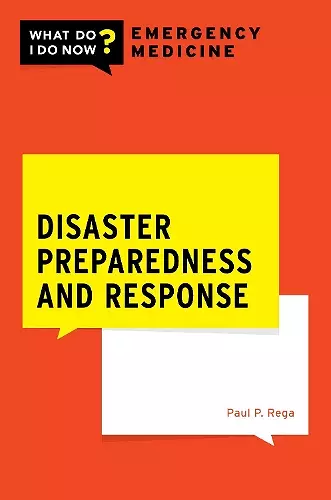Disaster Preparedness and Response
Format:Paperback
Publisher:Oxford University Press Inc
Published:14th Oct '22
Should be back in stock very soon

Disaster medicine has occupied an increasingly important niche within the specialty of emergency medicine over the latter half of the 20th century. Regardless of whether an event was natural, anthropogenic, or a combination of both, emergency medicine was and is the ideal discipline to develop the human resources, the strategies, the tactics, and the evidence- based research to elevate the field of disaster medicine. It began, organizationally speaking, with Hurricane Hugo in 1989 and it is continuing through the 2019 COVID- 19 pandemic and beyond. Now that we are well into the 21st century, we must steady our footing as a specialty on the 20th century's foundation so that we can wrestle with the more intricate challenges of the future. In the past two decades our global populations have experienced sectarian violence, wars, genocide, migration, terrorism, emerging infectious diseases, and pandemics. These natural and anthropogenic events will only worsen exponentially as we become intrinsically trapped by the effects of climate change. The United Nation's Intergovernmental Panel on Climate Change has recently concluded that regardless of how we try to reverse the effects of global warming, what we are experiencing now in terms of hurricanes, floods, and droughts will continue to worsen over the next 30 years. Should we, as a species, continue to equivocate and as global temperatures climb, these events will become more frequent and more catastrophic. "Catastrophic" may even be too mild a term. It is possible that over the next few years, the academic arm of emergency medicine may need to consider developing a curriculum devoted to "Cataclysmic Medicine." To confront these possibilities, there first needs to be a knowledge of disaster medicine and disaster management at its most basic level. It begins with crisis leadership, command and control, communications, and coordination. When all these pieces of the jigsaw puzzle are fitted together properly and enclosed by a proper ethical frame, then the best and most ethical and moral disaster medical can will be provided to the patient and to the community. The intent of this book is to introduce these concepts using diverse viewpoints and scenarios. Readers are challenged to cogitate, create, and layer their own set of building blocks upon the preexisting foundation, thereby reinforcing and sustaining their own capacity...
Dr. Rega's book reflects his decades-long interest in both the foundations and easily-overlooked subtleties of disaster preparedness. Expert care resides in the details, and the emergency physician will find within these pages a wealth of detailed, yet always accessible and eminently readable information to guide strategies for preparedness, training, self-protection, and patient care. As our community of emergency physicians prepares for the next challenge hovering in the darkness, let us thank Paul for illuminating a path forward." -Steven B. Abrams, MD, Attending Physician, Department of Emergency Medicine, Montefiore Medical Center, Bronx NY; Coordinating Editor, Practical Reviews in Emergency Medicine
Paul Rega's book represents the culmination of his career teaching and researching in the field of disaster management and uses the 'three e's: easy-to-read, educational, and entertaining. The topics are introduced by examples of disasters, using each example to introduce principles of disaster and mass casualty management. All emergency providers in every geographic location should be familiar with the principles and concepts of disaster management taught in this book, it is a must-read." -Bruce Janiak, Professor Emeritus of Emergency Medicine, Medical College of Georgia, Augusta University
It's all here: a comprehensive, thorough, and concise guide to the effective management of disasters of any description. Written by a widely-recognized expert in the field, it is full of practical strategies to assist anyone confronting the difficult task of emergency planning and contains an enormous amount of critical information that is difficult to find anywhere, let alone under one cover. It adeptly balances the need for accessibility, detail, and depth to become a one-stop guide to effective disaster planning, response, and resource allocation. Particularly useful to the emergency physician or emergency manager, it is an invaluable resource." -Ronald J. DiCecco, MD, FACEP, Emergency Physician, Critical Care Flight Physician, and EMS Medical Director of 30 years
ISBN: 9780197577516
Dimensions: 156mm x 236mm x 19mm
Weight: 567g
384 pages